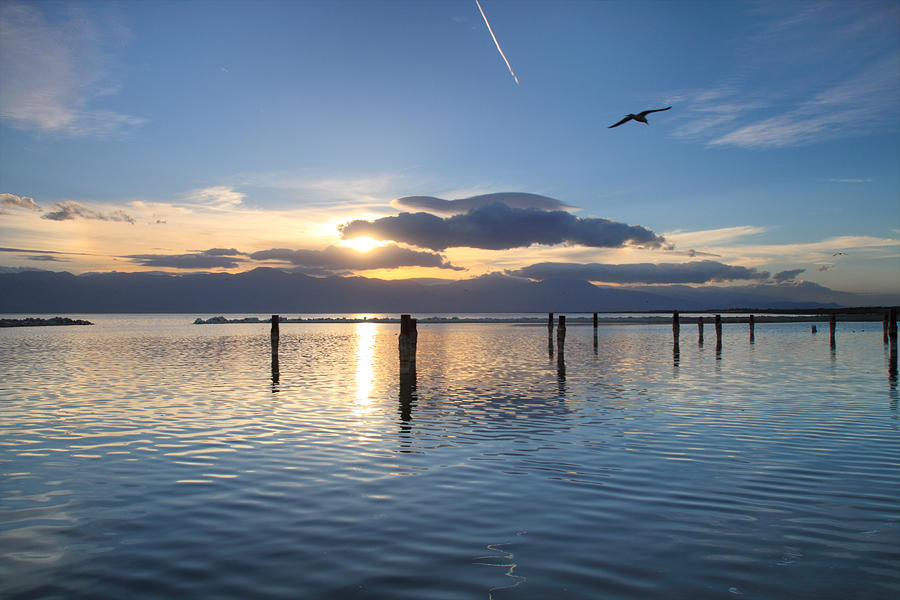
Abandoned buildings. Toxic dust. Dead birds. Selenium-laced waters.
It’s no surprise that most accounts of the Salton Sea wax apocalyptic – we’ve all seen the photographs – and an inevitable part of that narrative is the reminder that this blight isn’t natural, that the Sea only exists because the Colorado River burst through the banks of a man-made canal in 1905. Indeed, there are many who look at the problems at the Salton Sea and say that we should just let it go: empty the lake and let it go back to the way it was.
But that narrative gets us no closer to solving the problems down in Imperial County, and one of the main reasons is because it’s simply not true.
I’ll explain that in a moment, but in the meantime it’s important to point out that to the millions of birds that rely on the Salton Sea to survive, its creation was not an accident.
It was a godsend.
We see nearly 300 bird species at the Salton Sea. Hundreds of thousands of sandpipers migrating between Alaska and South America stop there, and up to 90 percent of the world’s Eared Grebes descend on it every winter. It provides essential breeding habitat for American White Pelicans, Double-crested Cormorants, and the threatened Snowy Plover. Without the Salton Sea, these and many others would struggle for survival.
While the creation of this habitat tracks to the 1905 flood, the Salton Sea sits in an ancient lakebed that has been filled by the Colorado River occasionally for eons.
When developers realized they could increase land value in California’s Imperial Valley with water from the Colorado River, this ancient lakebed sweetened the deal because it could be used for irrigation runoff. Once the break was fixed in 1907, this runoff continued to fill the Salton Sea. The plan was always to make a sea there. In other words, today’s Salton Sea is just as intentional as the Golden Gate Bridge.
For birds, the creation of the Salton Sea came at just the right time – just as humans began wiping out wetland habitat throughout California.
Two years before dredging began on the Imperial Valley canal, the last remnants of Tulare Lake disappeared. Once the largest freshwater lake in the West, Tulare Lake was nearly twice the size of the Salton Sea, and anchored more than five million acres of Central Valley wetlands, 95 percent of which are now gone.
In 1906, the federal government began work on the Klamath Project, which eventually eliminated 437 square miles (80 percent) of wetland habitat in the Klamath Basin along the California/Oregon border.
Just a few years later, the Los Angeles Department of Water and Power began diverting water from the 108-square-mile Owens Lake, where Native Americans recalled a sky blackened with migratory birds, and naturalist Joseph Grinnell found great numbers of avocets, phalaropes and ducks. By 1926, Owens Lake was gone.
In 1941, water was diverted from Mono Lake, a major stopping point for Eared Grebes, Wilson's Phalaropes and California Gulls. Although a protracted legal fight saved Mono Lake from elimination, it has never been the same.
Looking at all this, one might be tempted to call the Salton Sea California’s greatest habitat mitigation project. But the downside to all this habitat creation at the Salton Sea is that it depends on runoff water from farms that get their irrigation from the Colorado River – one of the most overtaxed watersheds in the country.
In 2003, the state struck a deal with water districts to divert some of that water for other uses. Knowing this would have a big effect on the ecology of the lake, needless to say the communities around it, the deal required additional water to be put into the lake for fifteen years to prop up its level to give the state time to perform dust reduction and habitat restoration projects. That deadline passed with very little accomplished on the ground, but the state made a new round of promises to get work done.
The state has now missed its 2018 goals for projects, and looks to be on track to miss its 2019 goals;, as well. But there is reason to be hopeful. New Gov. Gavin Newsom has said that the state needs to do more at the Salton Sea, and a sizeable amount of initial funding for projects has been approved through the state budget and the ballot box.
The Salton Sea may appear blighted to a casual human observer, but to a Western Sandpiper it is one of the last great inland sources of water, food, and habitat in the arid West. It is paradise.
That is something the birds probably share with the people living around the Salton Sea. This has been their home and livelihood for decades, and talking about it as though it is the result of human folly doesn’t get us an inch closer to addressing the urgent realities on the ground.
We owe it to the people and birds of the Salton Sea to take their plight seriously and make the sustained investments necessary to resolve it.
By Garrison Frost
Monthly Giving
Our monthly giving program offers the peace of mind that you’re doing your part every day.




